|
FAQs on the Hydrozoan Identification
4
Related Articles: Hydrozoans, Cnidarians, Fire Corals, Stylasterines, Hydrozoan Jellies,
Related FAQs: Hydrozoan ID 1, Hydrozoan ID 2, Hydrozoan ID 3, Hydrozoan ID 5, Hydrozoan ID 6, Hydrozoan ID 7, Hydrozoan ID 8, & Hydrozoans 1, Hydrozoans 2, Hydrozoan Behavior, Hydrozoan Compatibility, Hydrozoan Selection, Hydrozoan Systems, Hydrozoan Feeding, Hydrozoan Disease, Hydrozoan Reproduction,
Medusoids/Jellies (Ctenophores, some Hydrozoans,
Scyphozoans): Jelly Identification, Jelly Behavior, Jelly Compatibility, Jelly Selection, Jelly Systems, Jelly Feeding, Jelly Disease, Jelly Reproduction, Fire Corals,
Lace
Corals, Stinging-celled
Animals
|
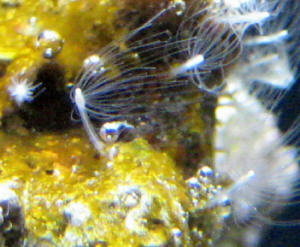
|
|
help indentify a red/brown type algae... no
pic, poor English... no reading 03/15/2008 I have
this reddish/brown type growth (im sure a algae) here is the
description. <Umm, really need a good photo...> It is very
fine. It grow approx. 2 inch in height. It looks like i a clump
of daisy's (Flowers) You could say it looks similar to a
daisy, and moves like a waving hand's coral. It spreads
quickly. Every 3 days it will die down where there is no flower
on top, looks like dead hair grass algae, but blooms again into a
full daisy. I have removed by hand but it breaks apart easily,
and of course attaches somewhere else. I have scrubbed it off.
and again back in full force. My tank is a reef friendly one.
Tangs/crabs/snails/urchins/Seahares none of them won't touch
it. It will spread to any of my hard corals that are damaged. But
the coral will not die from it. (Not yet anyway) I have looked at
many on line pictures or red hair type algae. But nothing looks
exactly like it just some similarities. I would like to know if
you have any idea what it might be, and if so, any cures? Your
help would be greatly appreciated. Thank you. mc <... a pic
please. That and/or a long read on WWM re Algal (et al.)
Identification: http://wetwebmedia.com/marinvind1.htm Bob
Fenner>
Red/brown type algae identification... Hydroids likely
3/19/08 Bob Fenner, thank you for your quick response.
Attached are photo's of my mysterious algae as per your
request. Again description: It is very fine, reddish/brown in
color. Grows like a bad weed. Moves like a wavy hands coral. Has
a flower type (Daisy) top on it. <I see this... am glad you
sent along such large file sizes... Cropped... maybe Myrionema or
such...> Every 3 - 4 days the flower dies down, and what's
left looks like red hair type algae, but will rebloom again. If
moved by hand it breaks apart easily. Will attach to any coral
that is damaged (hard coral) but doesn't seem to kill it yet.
Your help of what it is, and what might help get rid of it? Again
your help would be greatly appreciated. Thank you. MC <I do
believe this is likely a Hydrozoan, not an algae... Need even
"closer-up" pix to determine. Read here:
http://wetwebmedia.com/hyzoanidfaq.htm and the linked files Bob
Fenner>
|
|
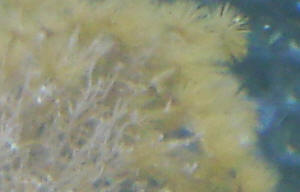
|
| Can You Identify This Please'¦ Hydroids
-- 03/08/08 Hello <Hi there, Mich here.> I have a
125-gallon marine tank that has been up for about 6 months - this
is my third tank. Can you please tell me what the small brown
things are - I believe that they are either a cluster of tiny glass
anemone (I haven't been able to find any pictures on the web of
tiny clustered glass anemones but did read on WetWebMedia that they
do come very small) <Nope.> or some sort of tiny cluster
feather dusters. <They are hydroids, perhaps Myrionema sp. They
can be a nuisance and you will need to wear gloves when removing
them as they can deliver a sting. They seem to be about 1/4 inch
long each. Let me know if the photo is not good enough and I will
get a friend with a better camera to take a picture. They are so
little it is actually difficult to see the details of them. <The
picture is fine. There also appear to be worm snails (Petaloconchus
spp) in the background, which are harmless filter feeders, but be
careful when moving about them as they can be quite sharp and
easily puncture finger tips.> I do know what a normal glass
anemone looks like and have had them before but never this tiny. I
did read on the site that the fish will avoid them and I have not
seen any fish stung but they do seem to avoid them. If these are
glass anemones I will try to remove them, <Hydroids are pests
and should be removed.> my biggest problem will be that they are
on one of the rocks my feather duster is attached to, which is
reasonably close to one of my bubble tip anemones. Can you suggest
the best way to remove these without damaging the feather duster or
the bubble tip anemone assuming it is tiny glass anemones. <Well
removal can be a bit of a challenge. If possible, you should remove
the rock from the system while you go about with the removal of
these buggers so they are not accidentally spread. You will likely
have to remove the top layer of the rock, as much as an inch with a
chisel or Dremel as these pests can attach themselves quite deeply
in the rock.> thanks for your help and for this wonderful
resource. <I am happy to help and I too thank all who have
contributed to this tremendous body of work. I was a student here
before I was a teacher.> regards Jackie for NZ <Cheers, Mich
from the good ole US of A.> |
|
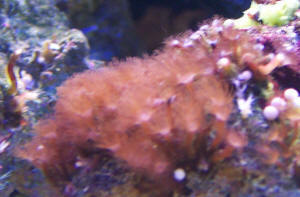
|
|
ID please -02/29/08 Please see attached. I can't tell
what it is, but hopefully someone can. :) <I'll try!>
Grows very tree like and on top of a colony of some palys. The
'polyps' withdraws into itself and tips becomes a whitish
color (like the ones up the top of the picture). When they're
open, they resemble zoas/palys, with a green center.
http://ericdo.com/pictures/Starfire%207.2.07/unknown_soft_022708.jpg
<Wow, that's certainly something different. Is there any
chance you could get a close up of the open and closed
polyps?> Please let me know if you guys can ID it. <To be
honest, I'm not even entirely sure it's even a coral...
but maybe some type of hydroid? More pictures will help.> Many
thanks, Eric <Best, Sara M.>
ID please -hydroids 02/29/08 <Eric- Just following
up... I asked one of my friends who is more of a marine invert ID
expert and he agrees with my guess that it's a hydroid of
some sort. But more importantly, he was able to explain a bit of
why he thinks so. The tubes are brown and translucent which
suggests they're proteinaceous, not calcium carbonate. That
means it's not a coral. And neither of us can think of
anything else (except a hydroid) that would have branching
proteinaceous tubes (and have polyps) like this thing has.
Hydroids are extremely difficult to ID, but if I can narrow it
down more at all, I'll let you know. :-) Best,
Sara M.>
|
|
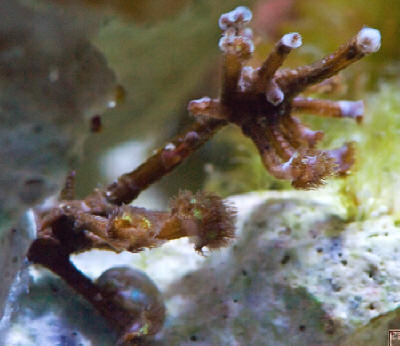 Outstanding. RMF. Outstanding. RMF.
|
|
Need Help With An ID No One Knows In My Reef
Forum 2/24/08 <Hi Jim, Mich here.> I bought snails from
the LFS and on 1 of the shells was this aiptasia looking thing,
that's what I assumed until it released itself and started
swimming. It swims like a octopus flailing its tentacles I've
posted on a reef forum and looked all over the Internet
researching this thing but have come up with nothing. Any help
would be appreciated. <Looks like a hydroid jellyfish to me.
More here:
http://www.ronshimek.com/Animal%20Groups%203%20Cnidarians.htm
http://www.wetwebmedia.com/jellyidfaqs.htm > I do have it in a
catch bucket but was wondering if it's safe to put it in my
reef. <Likely wouldn't hurt. Populations tend to wax and
wane. Is interesting to observer for sure.> Thank you for any
help you can give me. <Hope this helps. Mich>
Jim
|
|
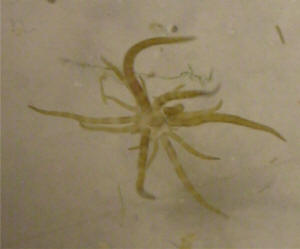
|
| What is this??? Hydroid Jellies (Staurocladia
oahuensis) and Gas Bubbles. 1/17/08 Hi everyone! <Hi
Rachel!> I have a couple questions with pics attached. The first
is, what are these white things on my glass? <Looks like hydroid
jellies (Staurocladia oahuensis) to me. Nothing to be concerned
about. They typically come and go. More here:
http://www.wetwebmedia.com/jellyidfaqs.htm
http://www.ronshimek.com/Animal%20Groups%203%20Cnidarians.htm >
They just showed up this afternoon. They look like star shaped bugs
or white spiders of some sort! I am getting close to the end of my
cycle with 0 ammonia, but my nitrites are still high. I am cycling
with live rock. (70 Lbs.) 55-gallon tank. Are they parasites? Will
they be harmful to fish when I add them after cycle completion?
<No.> The other photo is my substrate. These brown colored
seed like things are starting to show up in my substrate. Are they
eggs? <No, I think you are seeing the formation of gas bubbles.
Typically nothing to worry about.> I know I sound negative but I
don't know what all these things are and I don't want
anything harmful to my new fish when I add them. <No worries.
Better to be safe than sorry.> One more last question :) My
ammonia has been 0 for two days now. My nitrites are as high as the
chart will read for two days now. How long until my nitrites drop
to 0? <I'm sorry about the delayed response. I'm fairly
certain that they are likely dropped by now.> 20 lbs. live rock
introduced 3 weeks ago, and another 50 lbs. added one week ago.
Thank you once again for ALL of your help! <Welcome! And I'm
sorry for the delayed response. Mich> Rachel |
|
 .JPG)
|
| Hydro ID and help -- 1/04/08 Hi guys, Thanks
for maintaining such a wonderful site. I have been visiting this
site for over 4 years now and have always found to be a great
source of information. I need a little help though, and would
appreciate it if you guys could give me a hand. <Will gladly
render my input> I'm looking for a positive ID on this
little critter (see attached). After exhausting all resources here
at WWM on Hydrozoans, I went looking for better classifications of
these guys and I found a great site for identification:
http://www.ville-ge.ch/mhng/hydrozoa/hydrozoa-directory.htm. I
think I've come to the conclusion that this is probably Class
Hydrozoa, Order leptomedusae Family Malagazziidae <Appears so to
me as well> I only see them in the Hydroid colony stage.
Hopefully I'll never see the medusa stage ;) <Is, will be
there in time... likely being removed by your mechanical
filtration> Anyhow, looking through the articles at WWM I'm
trying to find out how to really get rid of these guys. Everything
I've seen at WWM says starve them out and remove the nutrient
rich environment. My question then becomes "what
nutrients?" <In boldest statement of what can be easily
measured, soluble nitrate, phosphate...> What do these guys
depend on to grow? <Mmm... some chemical base, micro-fauna... a
dearth of predators, competitors> Although, the appearance of
these things seem to correlate with my use of Koralle-VM from
Brightwell Aquatics. I have since changed to Coral-Vital from Marc
Weiss Companies, Inc to see if it will have a different effect.
<I would drop this Weiss product... and most all of its ilk>
They also seem to be accompanied by this brown looking mush on the
live rock. I have an 11 Gal Aqua-via tank, with an Aqua C remora
Protein skimmer with Maxi Jet 1200, 25lbs LR and a 3in sand bed. I
only have a couple of zoo's and a single clown fish. Not really
much of a bio-load here. The Aqua C should be more than enough of a
protein skimmer for this tank/load. Any ideas on how to starve
these guys out? Any specifics would be greatly appreciated. Thanks,
Jas <Mmm... well... I might try a small shrimp (or two)...
perhaps Lysmata wurdemanni... in the hopes of them eating up the
hydroids. Bob Fenner> |
|

|
Attn: Anthony Calfo -11/19/07 Hi
Anthony.. Just wanted to say thanks for your presentation in
Northampton PA. It was very entertaining and enlightening. I was the
guy who sat right next to you during the lunch. And I had asked you
about a certain brownish stringy growth in my tank. You had said that
it sounded like a form of something (not Cyano), but I'm having
trouble remembering what it was that you suggested it might be. If you
recall our conversation, could you please restate the name of the stuff
that you thought it might be? Once again. thank you so much for an
informative presentation. Jeff D. Thanks Bob/WWM crew for forwarding
Cheers, Jeff I mostly recall the conversation... hmmm, was this a
discussion about a filamentous hydroid? That's what's ringing a
bell to me. Can you share a picture by chance?
| Hairy turbo snail... Hydrozoans Hi, <Hello
there> I love your website--it has been a lifesaver for a newbie
like myself. <It is for you we generate it> I have searched
and searched but cannot find out what this is attached to my turbo
snail. They look like tentacles, are in pairs and about 4 sets
hanging out on him/her. Thanks in advance! Amber <I see these...
small, "fuzzy" hair-like projections... They're
likely hydropolyps... Hydrozoans... stinging, yes, but not likely a
real problem here. Please read:
http://wetwebmedia.com/hyzoanidfaq.htm Bob Fenner> |
|
.jpg)
|
|
|

